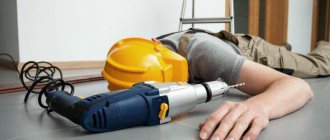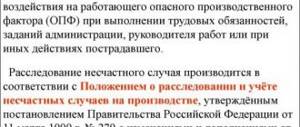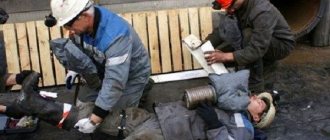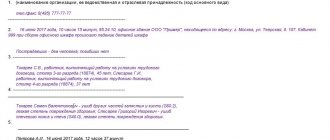How is the severity of an accident determined?
First of all, it is necessary to know who determines the severity of the accident. And this is not the employer and the management of the enterprise, but medical workers. Only they are involved in determining the severity of an accident at work.
Determination of the severity of an accident is regulated by Order No. 160 of the Ministry of Health and Social Development of Russia dated February 24, 2005 (hereinafter also referred to as Order No. 160). It is noteworthy that since this date the approach to determining the severity of an industrial accident has not changed.
Also see “Workplace Accident Notification Form”.
How should an investigation be conducted when an injury occurs at work?
Article 227 of the Russian Labor Code for each industrial accident determines the need to investigate it, as well as organize and keep records of them. The investigation is being led by a state labor inspector.
Among those against whom such an investigation is carried out, the legislation includes not only those who have an appropriate employment contract. It applies to anyone who, for an employer, takes part in its production process. This could be a trainee, someone involved in putting out a fire, a prisoner, or performing community service.
The investigation process should address any incidents that have the following consequences:
- — receipt of any bodily injuries, including those caused by other persons;
- - getting heatstroke;
- - receiving burn injuries;
- - getting frostbite to tissues and body parts;
- — damage caused by exposure to electric current or lightning, as well as any form of radiation;
- - receiving damage from animals and insects, including primarily bites;
- — damage caused by accidents.
Having discovered an accident at work or received a message about it, the employer is obliged to take a number of actions, which are determined by Article 228 of the Russian Labor Code. These include:
- providing first aid without any delay to someone who has had an accident at work, and if required, transporting him as quickly as possible to the nearest medical facility;
- take all measures to prevent any possibility of an emergency;
- as far as the situation allows and if this does not pose a threat to anyone, keep the situation in the “as it was” state until the moment when its investigation begins;
- if the situation does not allow, use video cameras, cameras and drawing up diagrams to record the situation;
- promptly inform a number of organizations and individuals about what has happened or is happening: relatives of the person who suffered an accident at work and the organization that sent him; labor inspection in Moscow; trade union; State Labor Inspectorate in Moscow; insurer and prosecutor's office.
In terms of notification, the situation of acute poisoning stands apart: if it is detected, in addition to the main list, the Federal Service, which is responsible for the supervision of human well-being in the field of consumer rights protection, must be notified.
It should be borne in mind that the fact that the medical care provided is timely and complete does not have any impact on how the severity of the injury will be assessed.
In its Article 230.1, the Russian Labor Code obliges employers to make a journal in which accidents are recorded.
Article 230 of the Russian Labor Code determines the procedure in which all materials of the ongoing investigation are drawn up. In particular, an act is drawn up according to a specially developed form N-1. This act must be drawn up in at least two copies - if there is only one victim, and one copy for each victim, if there were several. When the investigation is completed, this document is signed by the inspector himself, and is certified by the personal signature of the manager and the organizational seal.
As Article 212 of the Russian Labor Code states, it is the employer who is responsible for ensuring the proper level of safety for the working conditions provided by him. And if the investigation leads to the conclusion that this level was insufficient due to the fault of this employer, then he will face penalties. If the employer is an individual entrepreneur, these measures will be limited to a minimum of 1 thousand rubles. up to a maximum of 5 thousand rubles. For legal entities, the upper level of the fine no longer just grows to fifty thousand rubles - it can already include the suspension of its activities, as stated in Article 5.27 of the Russian Administrative Code.
Signs
Order No. 160 identifies the following qualifying signs of the severity of an industrial accident:
- the nature of the health damage and the ensuing complications, as well as the development and progression of chronic ailments in connection with the injury;
- consequences of health injuries (permanent loss of ability to work).
It is important that the presence of at least one of these signs is sufficient to classify accidents by severity - establishing a category.
A sign of a serious accident is also harm to health that threatens the life of the employee. At the same time, preventing death due to the provision of medical care does not affect the assessment of the severity of injury in an industrial accident.
Types of accidents
There is a common misconception about the unambiguous classification of an injury as industrial if it occurred on the territory of the actual place of performance of duties during working hours, and as domestic if it occurred on neutral territory or during non-working hours according to the schedule.
According to Article 227 of the Labor Code of the Russian Federation, the following types of accidents are subject to investigation:
- during working hours and the period necessary to prepare the immediate place of work for the production process, on the actual territory of the employer;
- during a lunch or technical break;
- on the way to work or home in a vehicle owned by the organization, as well as in a personal car used as a means of transportation with the permission of management;
- when moving around another locality during a business trip;
- when actually staying on the territory of another company or on the route due to the performance of official duties (couriers, forwarders).
According to the criterion for assessing the harm caused, accidents are divided into:
- mild injuries;
- severe injuries leading to long-term disability;
- injury to the body incompatible with life, causing death.
By the nature of the impact:
- extreme temperature conditions;
- poisoning with toxic chemicals;
- electric shock;
- mechanical stress, accompanied by the appearance of abrasions, bruises, dislocations and bone fractures.
Download the Work Accident Report (47.0 KiB, 233 hits)
Events that have occurred are subject to investigation, recording and recording in accordance with the established procedure. A preliminary analysis and classification is carried out in order to determine the composition of the commission, which differs from the type of incident.
Types of severe NS
Order No. 106 describes only severe accidents according to the severity of health damage. Therefore, mild cases are determined by the principle of exclusion: what is not severe is mild.
The table below provides a complete list of serious accidents.
| List of serious accidents | ||
| № | Diagnosis | What does it include |
| 1 | Health damage with an acute period of occurrence | May be accompanied by: • shock; • coma; • blood loss (volume – from 20%); • embolism; • acute failure of the functions of vital organs and systems (central nervous system, cardiac, vascular, respiratory, renal, hepatic and (or) a combination thereof). |
| 2 | Health injuries identified during the initial examination of the victim: • by hospital doctors; • trauma center; • or other honey. organizations. | The list is as follows: • penetrating wounds of the skull; • fracture of the skull and facial bones; • brain contusion; • intracranial injury; • injuries penetrating the lumen of the pharynx, trachea, esophagus, as well as damage to the thyroid and thymus glands; • penetrating injuries of the spine; • fracture-dislocations and fractures of the bodies or bilateral fractures of the arches of the I and II cervical vertebrae, including without dysfunction of the spinal cord; • dislocations (including subluxations) of the cervical vertebrae; • closed injuries of the cervical spinal cord; • fracture or fracture-dislocation of one or more thoracic or lumbar vertebrae, including without dysfunction of the spinal cord; • chest injuries penetrating the pleural cavity, pericardial cavity or mediastinal tissue, including without damage to internal organs; • abdominal wounds penetrating into the peritoneal cavity; • wounds penetrating the bladder cavity or intestines; • open wounds of the retroperitoneal organs (kidneys, adrenal glands, pancreas); • rupture of an internal organ of the thoracic or abdominal or pelvic cavity, retroperitoneal space, rupture of the diaphragm, rupture of the prostate gland, rupture of the ureter, rupture of the membranous part of the urethra; • bilateral fractures of the posterior semi-ring of the pelvis with rupture of the iliosacral joint and disruption of the continuity of the pelvic ring or double fractures of the pelvic ring in the anterior and posterior parts with disruption of its continuity; • open fractures of long tubular bones – humerus, femur and tibia, open injuries of the hip and knee joints; • damage to the main blood vessel: aorta, carotid (common, internal, external), subclavian, brachial, femoral, popliteal arteries or accompanying veins, nerves • radiation injuries of moderate (from 12 Gy) severity and higher; • abortion. Thermal (chemical) burns are specified separately: • III – IV degree with an affected area of 15% of the body surface; • III degree with a lesion area of 20% of the body surface; • II degree with a lesion area of 30% of the body surface; • respiratory tract, face and scalp. |
| 3 | Damage that does not directly threaten the life of the victim, but has serious consequences | These are: • loss of vision, hearing, speech; • loss of any organ or complete loss of its function by an organ (in this case, the loss of the most functionally important part of a limb (hand or foot) is equated to the loss of an arm or leg); • mental disorders; • loss of reproductive function and ability to bear children; • permanent facial disfigurement. |
Measures to prevent accidents at work
It is very important that every production facility has a qualified specialist who is responsible for occupational safety and health. He is hired by the manager, the owner of the company. In addition, each new employee must undergo training regarding work safety in a particular production facility. The fact that the employee has been instructed must be evidenced by his signature in a special journal.
If there are harmful working conditions in production, then employees should be trained on a regular basis in a special center or under the guidance of a commission organized for this purpose. After completing their studies, employees receive an appropriate certificate.
The employer’s responsibilities also include providing all staff members with personal protective equipment, information materials, and creating the most comfortable and safe working conditions.
conclusions
In the process of carrying out professional activities, the employee’s health may be harmed. If serious injuries occur, the situation during which they were acquired is recognized as a serious accident.
A special commission is being created to investigate what happened. During the inspection, the guilt of the employee and the employer is established, witnesses are interviewed, and a number of other activities are carried out. For attempts to conceal accidents, penalties may be applied to the employer.
How to fill out a letter of request to a medical institution
As stated earlier, only medical personnel have the right to determine the severity of work-related injuries. To draw up an incident report, the company needs to determine the extent and nature of the injury, obtain confirmation that the employee was sober, etc. To do this, the employer makes a request to the medical institution where the victim was taken.
The execution of a request does not have strict regulations; however, it must be completed in accordance with certain rules:
- It is written to the head physician of the medical institution where the victim was admitted.
- The name and address of the production are indicated.
- It is indicated to whom the letter was sent, indicating the address and name of the institution.
- The date, signature and seal are affixed.
Sample request to a medical institution
The body of the letter contains a request to obtain a medical report on the employee. Next, indicate his full name, date of birth, exact date and time of the incident. A request to clarify his condition (sober, alcoholic or drug intoxicated) at the time of admission is required. Next, indicate the desired form of the conclusion and the method of receipt (by mail, electronically, fax). Next is the boss’s signature and seal.
Thus, there are several degrees of severity of injuries received at work. The legislation and the Labor Code of the Russian Federation provide for compensation for employees who have suffered health damage. In some cases, an investigation is conducted to determine the cause of the injury. When severe damage occurs due to an insufficiently established occupational safety system at an enterprise, management bears responsibility for the incident.
Who has the responsibility to investigate?
Investigations into accidents at work, which are classified as serious, are carried out by a specially created commission. In such cases, as well as in the investigation of group accidents and fatalities, the composition should include a state labor inspector, an official representative of the executive authority, an association of trade union organizations, and an employee of the Social Insurance Fund authorized to conduct such investigations. In situations where the enterprise at which the accident took place is controlled by Rostechnadzor, the commission must also include its representative; in the absence of such a circumstance, he is replaced by a state inspector.
In situations where the victim expresses a desire to directly participate in the work of the commission, he has the right to do so (himself or with the help of a legal representative), while the employer does not have the right to contradict this. The period of work of the commission, in contrast to mild forms of injury to an employee, when the investigation must be completed within 3 days, is determined by 15 days - at the end of this period a report must be generated.
Types of cash payments and the procedure for receiving them
Everyone who is involved in the work process and has an employment contract in accordance with the Labor Code of the Russian Federation must be insured. For each employee, the company pays monthly insurance premiums, which in the event of a tragedy will be paid to the victim in accordance with the damage caused to health.
Industrial injuries: what is it, types
After establishing all the causes of the incident and confirming that the employee was in a sane state, an accident report is drawn up at the workplace, and the victim receives sick leave. Based on these two documents, the employee can apply to the Social Insurance Fund to issue a one-time payment or monthly payments.
To receive compensation, an application is written to the Social Insurance Fund and submitted in person, through State Services or the MFC. Along with it is served:
- act recording the incident;
- conclusion of the medical commission on the degree of injury and loss of ability to work in connection with this;
- an employment contract or employment record book for the production facility where the accident occurred;
- certificate of earnings for the last 2 years (if it is not possible to obtain a certificate from all places of work for the last two years, the Social Insurance Fund will request data from the Pension Fund).
Important! After submitting the documents, the Social Insurance Fund must, within 10 working days, consider the victim’s application and issue an order to accrue payments as to a disabled person. In 2021, the amount of a one-time payment cannot exceed 312,757 rubles, and the monthly benefit cannot exceed 78,189 rubles.
In addition, if the accident occurred due to the fault of the employer (improper organization of the workplace, purchase of low-quality equipment, violation of labor standards, etc.), the employee may demand additional payments from the company. Most of the court cases on this matter end with the satisfaction of the victim’s demands.










